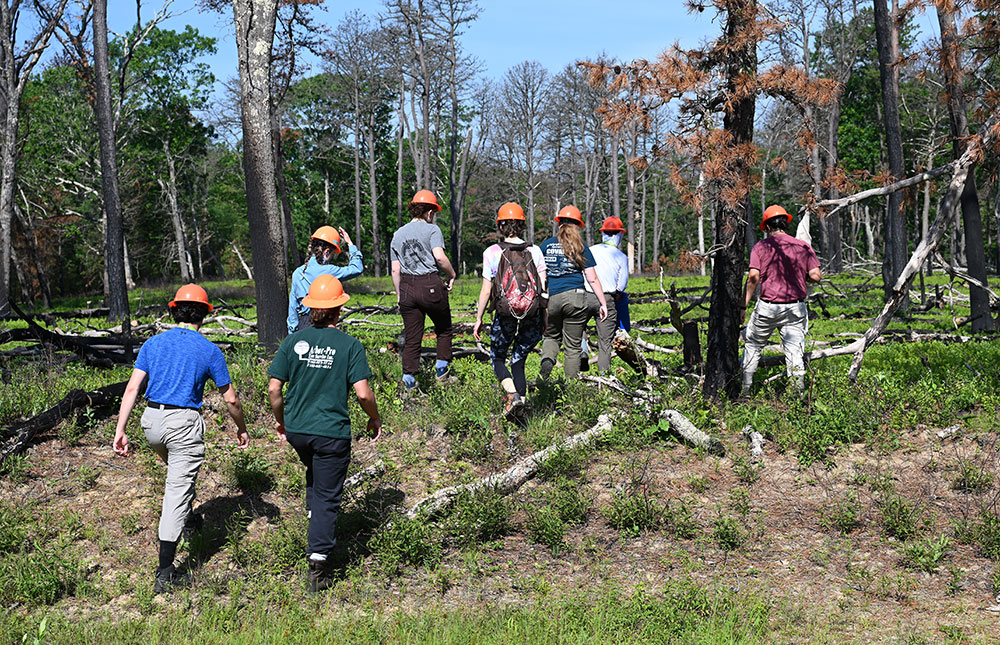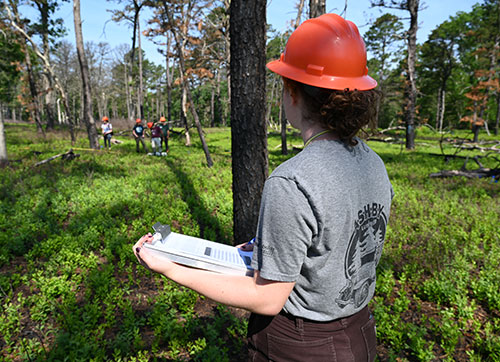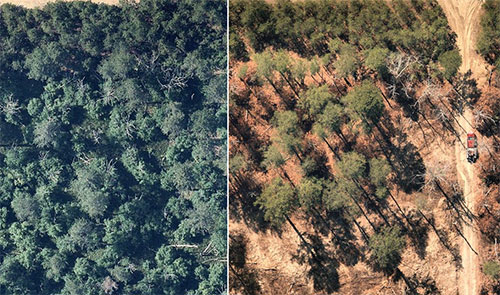Using Fire Management to See How Ticks…Tick
Ph.D. student and summer interns study how fire impacts notorious disease vectors
July 25, 2024
 enlarge
enlarge
Samuel Gilvarg, a graduate student from the State University of New York's College of Environmental Science and Forestry (SUNY ESF), holds up an ethanol vial containing a tick specimen. He and a group of SUNY ESF interns have been collecting ticks at Brookhaven National Laboratory to look for a connection between wildland fire history and relative tick abundance. (Kevin Coughlin/Brookhaven National Laboratory)
The morning alarm goes off, and it’s time to get ready for work. Ph.D. student Samuel Gilvarg has already pretreated his clothes with permethrin insecticide. All that’s left is to pull his socks up and over his pant legs.
This routine is a daily occurrence this summer for Gilvarg and his seven interns from the State University of New York’s College of Environmental Science and Forestry (SUNY ESF) to keep them safe while collecting data on the local tick population. Gilvarg has spent the past two summers at the U.S. Department of Energy’s (DOE) Brookhaven National Laboratory trying to understand how tick populations react to wildland fires. These are naturally-fueled vegetation fires that include both classic wildfires and prescribed burning, in which humans use fire as a management tool.
“I didn't just choose SUNY ESF interns because I go to SUNY ESF,” he said. “These students are what some call passionate and others call crazy enough to want to go work with ticks for an entire summer.”
For intern Melanie Costello, the research topic is personal. “Part of the reason I really wanted to do this internship is because my mom had Lyme disease for over 20 years,” she said.
Research probing the relationship between ticks and wildland fires might offer a new direction for managing the unruly disease-carrying pests, Gilvarg said.
 enlarge
enlarge
Gilvarg's seven interns, plus an additional helper, trek through the Long Island Pine Barrens to sample ticks on an experimental plot. (Kevin Coughlin/Brookhaven National Laboratory)
Small bite, big impact
The problem is getting more urgent, he noted.
“Tick-borne illness is really bad, and tick numbers are going up,” Gilvarg said, rattling off a list of debilitating tick-borne diseases: Lyme disease, anaplasmosis, ehrlichiosis, babesiosis, Powassan virus, Rocky Mountain spotted fever, and the alpha-gal allergy. Some of these conditions are associated with serious implications, including painful symptoms and mortality without proper medical treatment.
 enlarge
enlarge
Intern Molly Franklin looks on as her peers establish the border of an experimental plot. Each plot is 16-by-25-meters. (Kevin Coughlin/Brookhaven National Laboratory)
Alpha-gal syndrome, for example, transmitted by the bite of Lone Star ticks, induces an allergic reaction to mammalian products in certain people who’ve been bitten. Sometimes this can lead to delayed anaphylaxis — a constriction of the airway that makes it difficult or impossible to breathe — even hours after eating an allergen (e.g., red meat or dairy). In a recent Centers for Disease Control (CDC) study of 300,000 specimens from American patients suspecting they had alpha-gal syndrome, more than 30% tested positive.
To add to the challenge, most tick diseases are not passed directly from tick to tick or from mama tick through her eggs to the larvae, explained Timothy Green, Brookhaven’s on-site tick expert, who works in the Lab’s Environmental Protection Division. Instead, they pick up and pass on diseases as they feed during various stages of their complex life cycle.
“Tick larvae feed on small rodents, from which they pick up disease, then they molt to the nymph stage, get another blood meal from another host, and molt to the adult stage. As adults, they mate, and then the female must have another blood meal [likely on a deer] before laying eggs,” Green said. A tick that bites a human at any one of these stages could pass on the bacteria, viruses, or parasites that cause the tick-related diseases, he explained.
That means it’s not just the ticks that require study, but rather how they interact with other animals and the whole ecosystem around them.
“If you can break the reproductive cycle at any point, you can start managing for tick populations,” Green said. “Reduce mice, reduce ticks. Reduce deer, reduce ticks. Manage habitat, reduce ticks.”
 enlarge
enlarge
Interns Eric Jergensen (left) and Luke Myers (right) scan corduroy fabric they've dragged through the underbrush for any ticks that have latched on. They use this "corduroy on a stick" technique to census tick populations on plots that have experienced different burn histories. (Kevin Coughlin/Brookhaven National Laboratory)
Time is ticking
What Gilvarg wants to know is whether fire can be part of a plan to execute that last option. Using prescribed fire, he asks, “Can we build a forest that is not good for ticks?”
Brookhaven is a good place to find out. Undeveloped pine barrens forest makes up over 3,000 acres of the Laboratory’s 5,000-plus-acre property. In careful coordination with the Brookhaven Fire Rescue Group, the Lab’s Prescribed Fire Program, led by the Environmental Protection Division’s Kathy Schwager, regularly conducts prescribed burns. These fires decrease the amount of wildfire fuel on site, help prevent future out-of-control fires, and restore the ecosystem.
 enlarge
enlarge
An intern uses tweezers to pluck a tick off the corduroy. (Kevin Coughlin/Brookhaven National Laboratory)
“Without periodic fire, we will lose pine barrens,” Schwager said. She explained that this is a fire-adapted ecosystem, meaning it “requires fire for its very survival.” That leaves two options in her eyes: “Either we put fire on the landscape on our terms, or we wait for another wildfire that, if it burns under extreme conditions, may put people and property at risk.” No one wants a repeat of the infamous 2012 Crescent Bow Fire or the Sunrise Fire of 1995.
By collecting ticks from different burn locations at different intervals after wild or prescribed fires, Gilvarg and his interns have been assessing the impact of wildland fire on the tick populations.
“Fire should deliver a one-two punch,” he said, elaborating that it directly kills ticks and destroys some of the places they hide out and latch onto animals. Indeed, past evidence suggests that, right after a forest burns, leaf litter that has been charred black holds heat, leaving ticks with nowhere to take cover.
“Corduroy on a stick”
Gilvarg and his interns take precautions, like wearing permethrin-covered clothing, to avoid getting tick bites while collecting the data they need to test their hypothesis. To gather ticks, they use a method fondly called “corduroy on a stick.” A pair of interns drag large swaths of the textured fabric across 16-by-25-meter plots of underbrush. The interns then pluck hitchhiking ticks off the corduroy — and themselves, if applicable — depositing the specimens in ethanol vials for later counting. By sampling multiple sites with different burn histories, they can estimate relative tick abundance, which describes the presence of ticks actively out seeking a blood meal at the time of sampling, in each location.
 enlarge
enlarge
Intern Melanie Costello holds an ethanol vial against her hand to make the tick within more visible. The team tallies specimens back in the lab. (Kevin Coughlin/Brookhaven National Laboratory)
Some plots they sampled this summer had burned recently; others burned years ago. Some had burned several times, and some have never burned at all, according to the Lab’s records. That variation helps Gilvarg’s team tease apart the relationship between fire management and tick population density.
The scientists must also account for meteorological conditions during their tick-sampling studies. This is because an ideal tick habitat may return no ticks at all on a hot, dry day. Or an abysmal tick habitat could still be chock-full on a wet, cloudy one.
“It can get extremely hot and uncomfortable working in those conditions, but it’s great tick weather,” intern Erin Peskin said of the steamy heat and humidity. Brookhaven has many policies in place to ensure that interns and Lab staff stay safe while conducting research and during other activities on site.
Intern Eric Jergensen agreed, “It takes some getting used to [the weather], but regular meetings assessing the heat risks and precautions that can be taken to avoid such risks really ensure our productivity throughout the day and fortify our efficiency as a team.”
To collect the relevant weather data, the team carries devices called Kestrel Drops — sensors that sample temperature, relative humidity, heat index, and dew point every five seconds. At the end of each day, roughly 500 weather data points get delivered right to Gilvarg’s phone. He can then use statistics to filter out the impact of weather and see the true effect of wildland fire history on tick survival.
Fire’s bad reputation
It will be a while before Gilvarg’s team has analyzed enough data to draw conclusions. But even if they demonstrate that prescribed fire can be used as a tool to fight ticks and disease, they still have a public relations hurdle: People generally see fire as bad, as previous environmental education studies show.
“There's this whole culture predicated on Smokey the Bear fighting forest fires and fire as the enemy. While it’s well-intentioned, it’s misguided,” Gilvarg commented.
Aside from fire’s potentially positive role in mitigating tick populations, blanket anti-fire sentiment doesn’t consider nuances of local ecology.
 enlarge
enlarge
This map illustrates where the study's 23 plots are in relation to areas of previous fire. The experimental plots are marked with green, orange, or red dots depending on whether they are control/no-fire sites, infrequent-fire sites, or frequent-fire sites, respectively. The wildfires are denoted by amorphous shapes on the map, and the prescribed burns are identifiable as rectangles. The name and year of each fire, excluding the two most recent ones, are recorded in the legend. The bold, black line represents the border of Brookhaven's property. (Created by Gilvarg using Geographic Information System software and data courtesy of Prescribed Fire Program Manager Kathy Schwager)
For instance, in Upstate New York, fire truly is damaging for beech and hemlock forests. But “It’s totally different here,” Gilvarg stressed. “Pitch pine and oaks are built to burn, survive, and thrive after fire,” he said. In fact, some pitch pinecones even rely on fire’s heat to release seeds for reproduction. Again, as Schwager noted, this is a fire-adapted ecosystem that needs fire to survive.
But because the Long Island Pine Barrens, where Brookhaven is located, is a naturally moist ecosystem, fires ignited by lightning strikes aren’t common. In addition, due to long-term fire suppression and climate change on a larger scale, many forests in the Northeast are becoming wetter.
Without fire, Gilvarg explained, other trees take root, creating moist shade. And shade and moisture are exactly what ticks like. By using fire management, he said, “You can sort of reverse this process.”
But the solution isn’t as simple as setting the Barrens ablaze.
“Reduce mice, reduce ticks. Reduce deer, reduce ticks. Manage habitat, reduce ticks.”
— Timothy Green, Brookhaven’s on-site tick expert
“Previous studies suggest that if you burn a place once, or only a few times after a long absence of fire, it is actually going to increase ticks,” Gilvarg pointed out. That’s because the first thing to grow back is a flush of plants such as blueberry and huckleberry, which attract intermediary hosts for ticks to pick up disease. “To a deer, all those tender shoots are like an all-you-can-eat buffet.”
To account for the long, multistage lifecycle of the ticks and their relationship with deer and rodents, Gilvarg suggests the prescribed burn solution must be long-term. Repeated fires over a period of years, perhaps every three to five, might be what’s needed to keep ticks at bay, he said.
Gilvarg noted that Indigenous Peoples in the Northeast historically used and still use such routine prescribed fire practices. “It's people that kept the flame here,” he said. He highlighted the Mashpee Wampanoag’s fire management practices in places like upper Cape Cod as exemplary and said he considers restoring Indigenous practices of fire for forest management as a human rights issue, too.
Even in the best-case scenario, though, under a robust fire management program replete with regular burns, “We’re never going to completely eliminate ticks,” Gilvarg said. Instead, “Our goal is to reduce tick populations and disease risk.”
One way toward One Health
If burning adds a layer of protection against tick-borne disease, that would tie directly into One Health, a CDC framework for connecting ecosystem resilience, animal well-being, and human health.
Green appreciates Gilvarg’s work as an example of One Health studies related to tick management. “This One Health approach joins with our efforts to improve our ecosystem through management of the deer population,” he said. It further complements other methods for controlling vegetation, such as mechanically grinding up plants before implementing prescribed burns.
“The use of mechanical treatment and prescribed fire to improve ecosystem health also has an effect on the number of mice,” Green added. Figuring out how fire management affects incidence of tick-borne illness in rodents — while creating conditions that are less favorable for tick survival — will be key, he said.
 enlarge
enlarge
This aerial image displays a section of Brookhaven's property before (left) and after (right) a prescribed burn. A firetruck drives on the service road in the after photo. (Provided by intern Luke Myers from Nearmap, an aerial and satellite imagery service)
It all comes back to ecosystem interconnectedness. “That is why we are working with SUNY ESF and Sam to better understand the dynamics,” Green said.
Gilvarg ended on a hopeful note: “I genuinely believe that fire management for tick control could save a lot of lives and prevent a lot of sickness. I really think this could help a lot of people.”
Only time — and the data — will tell.
Gilvarg’s research is funded through the U.S. Department of Agriculture and by DOE’s support of Brookhaven National Laboratory.
Brookhaven National Laboratory is supported by the Office of Science of the U.S. Department of Energy. The Office of Science is the single largest supporter of basic research in the physical sciences in the United States and is working to address some of the most pressing challenges of our time. For more information, visit science.energy.gov.
Follow @BrookhavenLab on social media. Find us on Instagram, LinkedIn, X, and Facebook.
2024-21936 | INT/EXT | Newsroom









